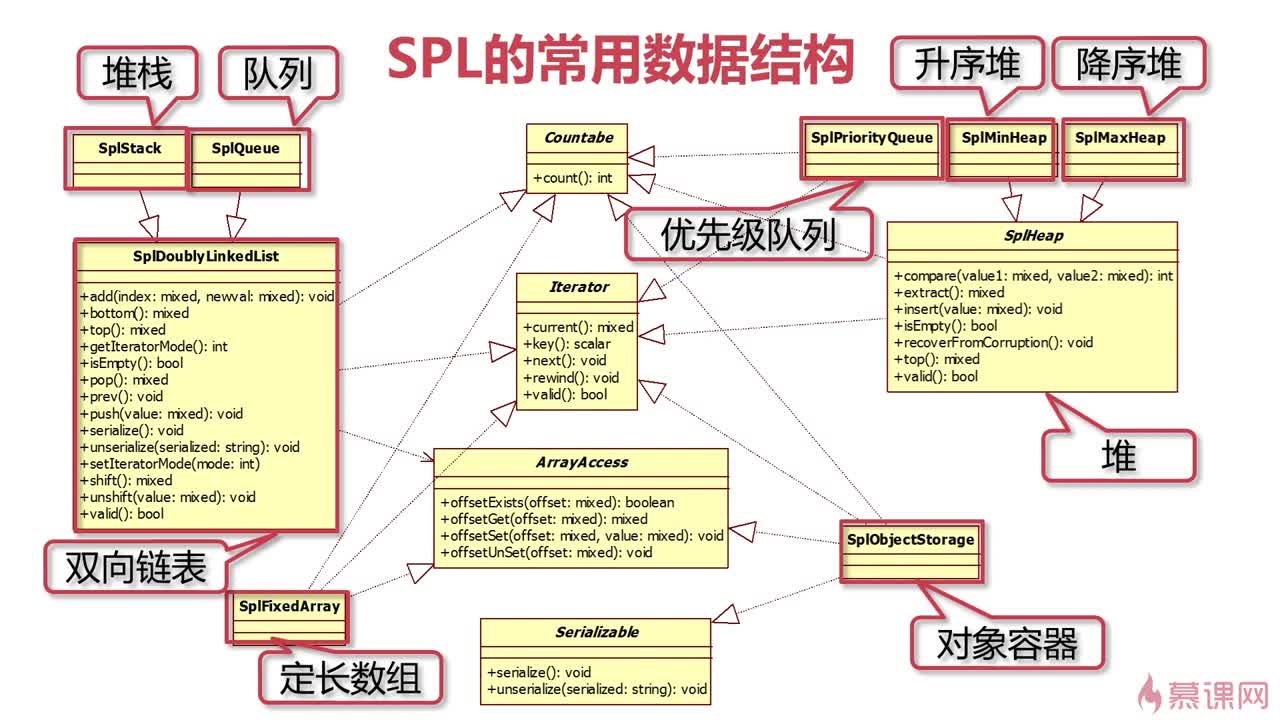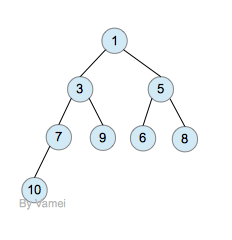SPL是Standard PHP Library(PHP标准库)的缩写。
The Standard PHP Library (SPL) is a collection of interfaces and classes that are meant to solve common problems.
官网说,SPL是用来解决典型问题(common problems)的一组接口与类的集合。
那么,什么是common problems呢?
- 数据结构
解决数据怎么存储问题
- 元素遍历
数据怎么查看
- 常用方法的统一调用
数组、集合大小
自定义遍历
- 类自动加载
spl_autoload_register
包含哪些内容?
- 数据结构
- 基础接口
- 基础函数
- 迭代器
- 异常
- 其它
SPL接口
Iterator 迭代器接口
SPL规定,所有实现了Iterator接口的class,都可以用在foreach Loop中。Iterator接口中包含5个必须实现的方法:
interface Iterator extends Traversable{ //返回当前元素 public mixed current ( void ); //返回当前元素的键 public scalar key ( void ); //向前移动到下一个元素 public void next ( void ); //返回到迭代器的第一个元素 public void rewind ( void ); //检查当前位置是否有效 public boolean valid ( void ); }
ArrayAccess 数组式访问接口
实现ArrayAccess接口,可以使得object像array那样操作。ArrayAccess接口包含四个必须实现的方法:
interface ArrayAccess { //检查一个偏移位置是否存在 public mixed offsetExists ( mixed $offset ); //获取一个偏移位置的值 public mixed offsetGet( mixed $offset ); //设置一个偏移位置的值 public mixed offsetSet ( mixed $offset ); //复位一个偏移位置的值 public mixed offsetUnset ( mixed $offset ); }
IteratorAggregate 聚合式迭代器接口
假设对象A实现了上面的ArrayAccess接口,这时候虽然可以像数组那样操作,却无法使用foreach遍历,除非实现了前面提到的Iterator接口。
另一个解决方法是,有时会需要将数据和遍历部分分开,这时就可以实现IteratorAggregate接口。它规定了一个getIterator()方法,返回一个使用Iterator接口的object。
IteratorAggregate extends Traversable { /* 获取一个外部迭代器 */ abstract public Traversable getIterator ( void ) }
示例:
<?php class myData implements IteratorAggregate { public $property1 = "Public property one"; public $property2 = "Public property two"; public $property3 = "Public property three"; public function __construct() { $this->property4 = "last property"; } public function getIterator() { return new ArrayIterator($this); } } $obj = new myData; foreach($obj as $key => $value) { var_dump($key, $value); echo "\n"; } ?>
注意:
虽然都继承自Traversable,但这是一个无法在 PHP 脚本中实现的内部引擎接口。我们直接使用IteratorAggregate 或 Iterator 接口来代替它。
RecursiveIterator
这个接口用于遍历多层数据,它继承了Iterator接口,因而也具有标准的current()、key()、next()、 rewind()和valid()方法。同时,它自己还规定了getChildren()和hasChildren()方法。The getChildren() method must return an object that implements RecursiveIterator。
SeekableIterator
SeekableIterator接口也是Iterator接口的延伸,除了Iterator的5个方法以外,还规定了seek()方法,参数是元素的位置,返回该元素。如果该位置不存在,则抛出OutOfBoundsException。
Countable
这个接口规定了一个count()方法,返回结果集的数量。
SPL数据结构
数据结构是计算机存储、组织数据的方式。
SPL提供了双向链表、堆栈、队列、堆、降序堆、升序堆、优先级队列、定长数组、对象容器。

基本概念
Bottom:节点,第一个节点称Bottom;
Top:最后添加的链表的节点称Top;
当前节点(Current):链表指针指向的节点称为当前节点;
SplDoublyLinkedList 双向链表
SplDoublyLinkedList 实现了Iterator , ArrayAccess , Countable接口。
类摘要
SplDoublyLinkedList implements Iterator , ArrayAccess , Countable { /* 方法 */ public __construct ( void ) public void add ( mixed $index , mixed $newval ) public mixed bottom ( void ) public int count ( void ) public mixed current ( void ) public int getIteratorMode ( void ) public bool isEmpty ( void ) public mixed key ( void ) public void next ( void ) public bool offsetExists ( mixed $index ) public mixed offsetGet ( mixed $index ) public void offsetSet ( mixed $index , mixed $newval ) public void offsetUnset ( mixed $index ) public mixed pop ( void ) public void prev ( void ) public void push ( mixed $value ) public void rewind ( void ) public string serialize ( void ) public void setIteratorMode ( int $mode ) public mixed shift ( void ) public mixed top ( void ) public void unserialize ( string $serialized ) public void unshift ( mixed $value ) public bool valid ( void ) }
注意:SplDoublyLinkedList::setIteratorMode用来设置链表模式:
迭代方向:
SplDoublyLinkedList::IT_MODE_LIFO (Stack style)
SplDoublyLinkedList::IT_MODE_FIFO (Queue style)
迭代器行为:
SplDoublyLinkedList::IT_MODE_DELETE (Elements are deleted by the iterator)
SplDoublyLinkedList::IT_MODE_KEEP (Elements are traversed by the iterator)
默认模式: SplDoublyLinkedList::IT_MODE_FIFO | SplDoublyLinkedList::IT_MODE_KEEP
当前节点操作:
rewind:将链表的当前指针指向第一个元素
current:链表当前指针,当节点被删除后,会指向空节点
prev:上一个
next:下一个
增加节点操作:
push 在双向链表的结尾处将元素压入
unshift 前置双链表元素,预备值在双链表的开始
删除节点操作:
pop 从双向链表的结尾弹出一个节点,不会改变指针位置
shift从双向链表的开头弹出一个节点,不会改变指针位置
定位操作:
bottom 返回当前双向链表的第一个节点的值,当前指针不变
top返回当前双向链表的最后一个节点的值,当前指针不变
特定节点操作:
offsetExists 理解为key是否存在
offsetGet将key节点拿出来
offsetSet把数据刷新
offsetUnset删除
示例:SplDoublyLinkedList.php
<?php /** *SplDoublyLinkedList 类学习 */ $obj = new SplDoublyLinkedList(); $obj -> push(1);//把新的节点添加到链表的顶部top $obj -> push(2); $obj -> push(3); $obj -> unshift(10);//把新节点添加到链表底部bottom print_r($obj); $obj ->rewind();//rewind操作用于把节点指针指向Bottom所在节点 $obj -> prev();//使指针指向上一个节点,靠近Bottom方向 echo 'next node :'.$obj->current().PHP_EOL; $obj -> next(); $obj -> next(); echo 'next node :'.$obj->current().PHP_EOL; $obj -> next(); if($obj -> current()) echo 'current node valid'.PHP_EOL; else echo 'current node invalid'.PHP_EOL; $obj ->rewind(); //如果当前节点是有效节点,valid返回true if($obj->valid()) echo 'valid list'.PHP_EOL; else echo 'invalid list'.PHP_EOL; print_r($obj); echo 'pop value :'.$obj -> pop().PHP_EOL; print_r($obj); echo 'next node :'.$obj ->current().PHP_EOL; $obj ->next();//1 $obj ->next();//2 $obj -> pop();//把top位置的节点从链表中删除,并返回,如果current正好指>向top位置,那么调用pop之后current()会失效 echo 'next node:'.$obj -> current().PHP_EOL; print_r($obj); $obj ->shift();//把bottom位置的节点从链表中删除,并返回 print_r($obj);
SplStack 栈
栈(Stack)是一种特殊的线性表,因为它只能在线性表的一端进行插入或删除元素(即进栈和出栈)。
栈是一种后进先出(LIFO)的数据结构。
SplStack 继承自 双向链表 SplDoublyLinkedList。
示例:
<?php $stack = new SplStack(); $stack->push(1); $stack->push(2); $stack->push(3); echo 'bottom:'.$stack -> bottom().PHP_EOL; echo "top:".$stack->top().PHP_EOL; //堆栈的offset=0,是top所在位置(即栈的末尾) $stack -> offsetSet(0, 10); echo "top:".$stack->top().'<br/>'; //堆栈的rewind和双向链表的rewind相反,堆栈的rewind使得当前指针指向top所在位置,而双向链表调用之后指向bottom所在位置 $stack -> rewind(); echo 'current:'.$stack->current().'<br/>'; $stack ->next();//堆栈的next操作使指针指向靠近bottom位置的下一个节点,而双向链表是靠近top的下一个节点 echo 'current:'.$stack ->current().'<br/>'; //遍历堆栈 $stack -> rewind(); while ($stack->valid()) { echo $stack->key().'=>'.$stack->current().PHP_EOL; $stack->next();//不从链表中删除元素 } echo '<br/>'; echo $stack->pop() .'--'; echo $stack->pop() .'--'; echo $stack->pop() .'--';
输出:
bottom:1 top:3 top:10 current:10 current:2 2=>10 1=>2 0=>1 10--2--1--
SplQueue 队列
队列是一种先进先出(FIFO)的数据结构。使用队列时插入在一端进行而删除在另一端进行。

SplQueue 也是继承自 双向链表 SplDoublyLinkedList,并有自己的方法:
/* 方法 */ __construct ( void ) mixed dequeue ( void ) void enqueue ( mixed $value ) void setIteratorMode ( int $mode )
示例1:
<?php $queue = new SplQueue(); $queue->enqueue(1); $queue->enqueue(2); echo $queue->dequeue() .'--'; echo $queue->dequeue() .'--'; //1--2--
示例2:
<?php $obj = new SplQueue(); $obj -> enqueue('a'); $obj -> enqueue('b'); $obj -> enqueue('c'); echo 'bottom:'.$obj -> bottom().PHP_EOL; echo 'top:'.$obj -> top(); echo '<br/>'; //队列里的offset=0是指向bottom位置 $obj -> offsetSet(0,'A'); echo 'bottom:'.$obj -> bottom(); echo '<br/>'; //队列里的rewind使得指针指向bottom所在位置的节点 $obj -> rewind(); echo 'current:'.$obj->current(); echo '<br/>'; while ($obj ->valid()) { echo $obj ->key().'=>'.$obj->current().PHP_EOL; $obj->next();// } echo '<br/>'; //dequeue操作从队列中提取bottom位置的节点,并返回,同时从队列里面删除该元素 echo 'dequeue obj:'.$obj->dequeue(); echo '<br/>'; echo 'bottom:'.$obj -> bottom().PHP_EOL;
输出:
bottom:a top:c bottom:A current:A 0=>A 1=>b 2=>c dequeue obj:A bottom:b
SplHeap 堆
堆(Heap)就是为了实现优先队列而设计的一种数据结构,它是通过构造二叉堆(二叉树的一种)实现。
根节点最大的堆叫做最大堆或大根堆,根节点最小的堆叫做最小堆或小根堆。二叉堆还常用于排序(堆排序)。
SplHeap 是一个抽象类,实现了Iterator , Countable接口。最大堆(SplMaxHeap)和最小堆(SplMinHeap)就是继承它实现的。最大堆和最小堆并没有额外的方法。
如皋要使用SplHeap类,需要实现其抽象方法int compare ( mixed $value1 , mixed $value2 )。
类摘要:
abstract SplHeap implements Iterator , Countable { /* 方法 */ public __construct ( void ) abstract protected int compare ( mixed $value1 , mixed $value2 ) public int count ( void ) public mixed current ( void ) public mixed extract ( void ) public void insert ( mixed $value ) public bool isEmpty ( void ) public mixed key ( void ) public void next ( void ) public void recoverFromCorruption ( void ) public void rewind ( void ) public mixed top ( void ) public bool valid ( void ) }
示例:
<?php class MySimpleHeap extends SplHeap { //compare()方法用来比较两个元素的大小,绝对他们在堆中的位置 public function compare( $value1, $value2 ) { return ( $value1 - $value2 ); } } $obj = new MySimpleHeap(); $obj->insert( 4 ); $obj->insert( 8 ); $obj->insert( 1 ); $obj->insert( 0 ); echo $obj->top(); //8 echo $obj->count(); //4 echo '<br/>'; foreach( $obj as $number ) { echo $number.PHP_EOL; }
输出:
84 8 4 1 0
SplMaxHeap 最大堆
最大堆(SplMaxHeap)继承自抽象类SplHeap实现的。最大堆并没有额外的方法。
SplMinHeap 最小堆
最小堆(SplMinxHeap)继承自抽象类SplHeap实现的。最小堆并没有额外的方法。
如下:最小堆(任意节点的优先级不小于它的子节点)

示例:
<?php $obj = new SplMinHeap(); $obj->insert(4); $obj->insert(8); //提取 echo $obj->extract(). PHP_EOL; echo $obj->extract(); //4 8
SplPriorityQueue 优先级队列
优先级队列SplPriorityQueue是基于堆实现的。和堆一样,也有int compare ( mixed $priority1 , mixed $priority2 )方法。
SplPriorityQueue 实现了Iterator , Countable 接口。
示例:
$pq = new SplPriorityQueue(); $pq->insert('a', 10); $pq->insert('b', 1); $pq->insert('c', 8); echo $pq->count() .PHP_EOL; //3 echo $pq->current() . PHP_EOL; //a /** * 设置元素出队模式 * SplPriorityQueue::EXTR_DATA 仅提取值 * SplPriorityQueue::EXTR_PRIORITY 仅提取优先级 * SplPriorityQueue::EXTR_BOTH 提取数组包含值和优先级 */ $pq->setExtractFlags(SplPriorityQueue::EXTR_DATA); while($pq->valid()) { print_r($pq->current()); //a c b $pq->next(); }
SplFixedArray 定长数组
SplFixedArray 实现了Iterator , ArrayAccess , Countable 接口。
和普通数组不一样,定长数组规定了数组的长度。优势就是比普通的数组处理更快。
<?php $arr = new SplFixedArray(5); $arr[0] = 1; $arr[1] = 2; $arr[2] = 3; print_r($arr); //SplFixedArray Object ( [0] => 1 [1] => 2 [2] => 3 [3] => [4] => )
SplObjectStorage 对象容器
SplObjectStorage是用来存储一组对象的,特别是当你需要唯一标识对象的时候。该类实现了Countable ,Iterator ,Serializable ,ArrayAccess四个接口。可实现统计、迭代、序列化、数组式访问等功能。
示例:
class A { public $i; public function __construct($i) { $this->i = $i; } } $a1 = new A(1); $a2 = new A(2); $a3 = new A(3); $a4 = new A(4); $container = new SplObjectStorage(); //SplObjectStorage::attach 添加对象到Storage中 $container->attach($a1); $container->attach($a2); $container->attach($a3); //SplObjectStorage::detach 将对象从Storage中移除 $container->detach($a2); //SplObjectStorage::contains用于检查对象是否存在Storage中 var_dump($container->contains($a1)); //true var_dump($container->contains($a4)); //false //遍历 $container->rewind(); while($container->valid()) { var_dump($container->current()); $container->next(); }
SPL类
SPL的内置类
SPL除了定义一系列Interfaces以外,还提供一系列的内置类,它们对应不同的任务,大大简化了编程。
查看所有的内置类,可以使用下面的代码:
<?php // a simple foreach() to traverse the SPL class names foreach(spl_classes() as $key=>$value) { echo $key.' -> '.$value.'<br />'; } ?>
SplFileInfo
PHP SPL中提供了SplFileInfo和SplFileObject两个类来处理文件操作。
SplFileInfo用来获取文件详细信息:
$file = new SplFileInfo('foo-bar.txt'); print_r(array( 'getATime' => $file->getATime(), //最后访问时间 'getBasename' => $file->getBasename(), //获取无路径的basename 'getCTime' => $file->getCTime(), //获取inode修改时间 'getExtension' => $file->getExtension(), //文件扩展名 'getFilename' => $file->getFilename(), //获取文件名 'getGroup' => $file->getGroup(), //获取文件组 'getInode' => $file->getInode(), //获取文件inode 'getLinkTarget' => $file->getLinkTarget(), //获取文件链接目标文件 'getMTime' => $file->getMTime(), //获取最后修改时间 'getOwner' => $file->getOwner(), //文件拥有者 'getPath' => $file->getPath(), //不带文件名的文件路径 'getPathInfo' => $file->getPathInfo(), //上级路径的SplFileInfo对象 'getPathname' => $file->getPathname(), //全路径 'getPerms' => $file->getPerms(), //文件权限 'getRealPath' => $file->getRealPath(), //文件绝对路径 'getSize' => $file->getSize(),//文件大小,单位字节 'getType' => $file->getType(),//文件类型 file dir link 'isDir' => $file->isDir(), //是否是目录 'isFile' => $file->isFile(), //是否是文件 'isLink' => $file->isLink(), //是否是快捷链接 'isExecutable' => $file->isExecutable(), //是否可执行 'isReadable' => $file->isReadable(), //是否可读 'isWritable' => $file->isWritable(), //是否可写 ));
SplFileObject
SplFileObject继承SplFileInfo并实现RecursiveIterator、 SeekableIterator接口 ,用于对文件遍历、查找、操作遍历:
try { foreach(new SplFileObject('foo-bar.txt') as $line) { echo $line; } } catch (Exception $e) { echo $e->getMessage(); }
查找指定行:
try { $file = new SplFileObject('foo-bar.txt'); $file->seek(2); echo $file->current(); } catch (Exception $e) { echo $e->getMessage(); }
写入csv文件:
$list = array ( array( 'aaa' , 'bbb' , 'ccc' , 'dddd' ), array( '123' , '456' , '7891' ) ); $file = new SplFileObject ( 'file.csv' , 'w' ); foreach ( $list as $fields ) { $file -> fputcsv ( $fields ); }
DirectoryIterator
该类继承自SplFileInfo并实现SeekableIterator接口。
这个类用来查看一个目录中的所有文件和子目录:
<?php try{ /*** class create new DirectoryIterator Object ***/ foreach ( new DirectoryIterator('./') as $Item ) { echo $Item.'<br />'; } } /*** if an exception is thrown, catch it here ***/ catch(Exception $e){ echo 'No files Found!<br />'; } ?>
ArrayObject
该类实现了ArrayAccess ,Countable, IteratorAggregate, Serializable接口。
这个类可以将Array转化为object。
<?php /*** a simple array ***/ $array = array('koala', 'kangaroo', 'wombat', 'wallaby', 'emu', 'kiwi', 'kookaburra', 'platypus'); /*** create the array object ***/ $arrayObj = new ArrayObject($array); /*** iterate over the array ***/ for($iterator = $arrayObj->getIterator(); /*** check if valid ***/ $iterator->valid(); /*** move to the next array member ***/ $iterator->next()) { /*** output the key and current array value ***/ echo $iterator->key() . ' => ' . $iterator->current() . '<br />'; } ?>
ArrayIterator
该类实现了ArrayAccess, Countable , SeekableIterator , Serializable 接口。
这个类实际上是对ArrayObject类的补充,为后者提供遍历功能。
<?php /*** a simple array ***/ $array = array('koala', 'kangaroo', 'wombat', 'wallaby', 'emu', 'kiwi', 'kookaburra', 'platypus'); try { $object = new ArrayIterator($array); foreach($object as $key=>$value) { echo $key.' => '.$value.'<br />'; } } catch (Exception $e) { echo $e->getMessage(); } ?>
参考
1、PHP: SPL - Manual
http://php.net/manual/zh/book.spl.php
2、PHP: 预定义接口 - Manual
http://php.net/manual/zh/reserved.interfaces.php
3、PHP SPL笔记 - 阮一峰的网络日志
http://www.ruanyifeng.com/blog/2008/07/php_spl_notes.html
4、PHP SPL标准库之文件操作(SplFileInfo和SplFileObject) - PHP点点通
http://www.phpddt.com/php/SplFileObject.html



